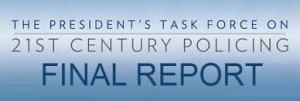Trust between law enforcement agencies and the people they protect and serve is essential in a democracy. It is key to the stability of our communities, the integrity of our criminal justice system, and the safe and effective delivery of policing services. In light of recent events that have exposed rifts in the relationships between local police and the communities they protect and serve, on December 18, 2014, President Barack Obama signed an executive order establishing the Task Force on 21st Century Policing. The President charged the task force with identifying best practices and offering recommendations on how policing practices can promote effective crime reduction while building public trust.
The Task Force met seven times in January and February of 2015. These listening sessions, held in Washington, D.C.; Phoenix, Arizona; and Cincinnati, Ohio, brought the 11 members of the task force together with more than 100 individuals from diverse stakeholder groups—law enforcement officers and executives, community members, civic leaders, advocates, researchers, academics, and others—in addition to many others who submitted written testimony to study the problems from all perspectives.
The task force recommendations, each with action items, are organized around six main topic areas or “pillars:” Building Trust and Legitimacy, Policy and Oversight, Technology and Social Media, Community Policing and Crime Reduction, Officer Training and Education, and Officer Safety and Wellness. The plan was unveiled in May of 2015.
The 6 pillars serve as a road map for the future of policing and provides clear direction on how to build trust with the public. The 6th pillar specifically addresses Officer Safety and Wellness.
As many of you know, a large proportion of officer injuries and deaths are not the result of interaction with criminal offenders but the outcome of poor physical health due to poor nutrition, lack of exercise, sleep deprivation, and substance abuse. Yet these causes are often overlooked or given scant attention.
The wellness and safety of law enforcement officers is critical not only to themselves, their colleagues, and their agencies, but also to public safety.
Click here for resources to help with Officer Safety and Wellness.
Click here for how Public Safety Medical can help your department.
Click on the image below to review the final report from the Task Force.








